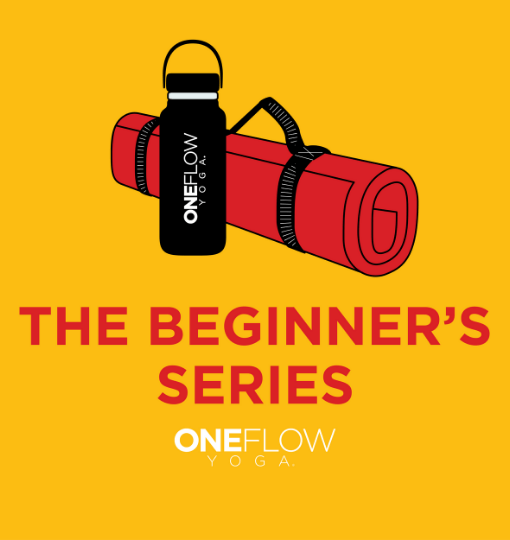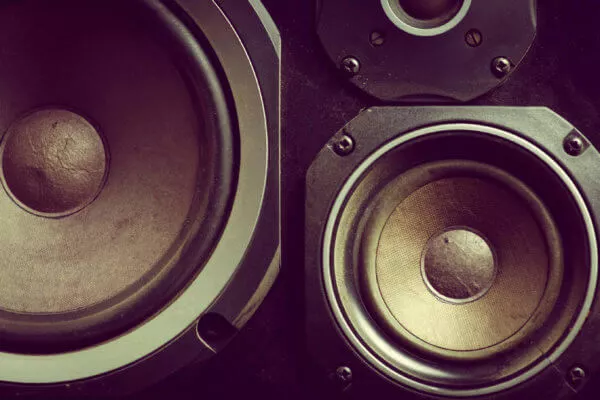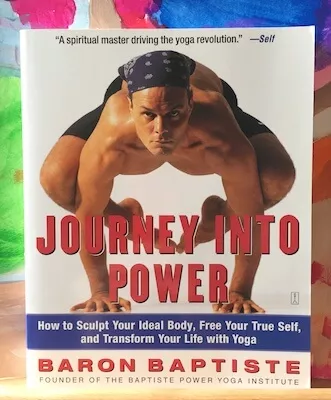Power Yoga. Even if you never heard of it, odds are it’s affecting the way you think about and practice yoga. Why? Because it’s popular and athletic—the very definition of modern yoga. It’s worth understanding Power Yoga because even though it’s one of the most prolific forms of yoga in the United States, it can be difficult to define and has more names than someone running from the law.
Names of Power Yoga: Power yoga (a.k.a “Power Vinyasa Yoga,” a.k.a. “Power Flow,” a.k.a. “hot Power Yoga,” a.k.a “Baptiste Power Yoga”)
Keep reading, and we’ll explore what Power Yoga is, where it came from, and the original intention behind it.
“But I practice Iyengar,” you say. I get that. BKS Iyengar set out to deliberately popularize yoga. The explosion of yoga in the world and fact that it’s the number one group exercise Americans participate in (source: Mindbody Fitness in America report) says that Iyengar did it. One of the consequences of being successful is that it spawns variation, like Power Yoga.
What gets overlooked is Power Yoga never meant to become what it is today. The creators saw it as a “gateway yoga” where you come for the abs but stay for the deeper prospect of yoga.
What is Power Yoga?
When you think of a Power Yoga practice, think:
- Amped up class
- Loud Music
- Hot environment (90 ℉ | 32 ℃+)
- Lots of movement
Power Yoga classes are active and frenetic like that one friend you had in school that stayed out all night because they wanted to “PARTY.” There is a heavy emphasis on standing postures because moving your legs gets your heart pumping—a key component of Power Yoga—cardio.
Where did Power Yoga Come From?
Two people get credit for coining the term—Beryl Bender Birch and Bryan Kest—in the late 1980s.
Beryl, who wrote the book, Power Yoga, practiced and taught Ashtanga Yoga in New York. She noticed that “runners and athletes” were “so tight no one could do the postures.”
To her credit, she modified the Ashtanga practice to meet people where they are and called it “Stretching and strengthening for athletes.” “I thought it was such a fantastic practice for athletes. You don’t stretch to warm up for running, or cycling or tennis…you’ve got to get sweating.”
She would go through one more name “Yoga for athletes” before finally coming up with the winner, “Power Yoga.”
Beryl told About.com’s, Ann Pizer:
Power Yoga was simply a name, the name I came up with in the late ’80s to let people know that this Ashtanga yoga practice – unlike most of the yoga taught in the 70’s – was a serious workout…
She goes on to say, in an interview with J. Brown:
I could not trademark it, though I tried. Byran Kest tried… We kind of both came up with the name at the same time. He was on the West Coast; I was on the East coast… Baron (Baptise) got the name from me. Because it wasn’t trademarked Power Yoga became anything and everything.
We learn a few things here:
- In the beginning, Power Yoga was a modified Ashtanga Yoga practice.
- The emphasis was on a “serious workout” rather than mere stretching.
- It was oriented towards athletes.
- Power yoga became “anything and everything.”
The critical phrase that Beryl picked up on is “workout.” Ashtanga is tough stuff. It’s a fixed sequence practice, meaning you do the same groups of postures every time. There are six sequences in total, called series, and you must complete one before going on to the next. There is a lot of movement in Ashtanga Yoga, and you have to have a lot of flexibility to do many of the postures.
In order to bring Ashtanga to the masses, it would have to change a lot.
Bryan Kest simultaneously came up with the name Power Yoga. Like Beryl, Bryan, located in Santa Monica, CA, was trying to figure out a way to make yoga accessible to more people. Instead of athletic names, Bryan mused over terms like “Grandma Yoga” because “I wanted grandmas to feel welcome in class.”
Thankfully “Grandma Yoga” was abandoned as no one wants to practice it, not even your grandma. Instead, we seek to be fit.
The Original Intention of Power Yoga
When you listen to Beryl and Bryan talk about the practice and read what they have written, it is obvious all of them understand the philosophy of yoga on an intimate level.
Power Yoga is directed at creating the highest level of energy, vitality, and freedom. The only way to do this is to work with yourself, not against yourself. By working hard sensitively, we create an environment that’s healing and that honors each individual, an environment that respects our boundaries and works within him or her. In this way, we create an atmosphere conducive to natural expansion and growth. We’re not interested in pushing past our edge to get to a place where we’ve been brainwashed into thinking we need to be in order to have happiness!
Bryan Kest
Yoga’s about learning to pay attention. Attention drives transformation. My interest was in the philosophy and the spiritual aspect of yoga, but you have to match impedance levels with your audience. You have to teach people where they are at. If you start with fitness…it gets people in the door.
Beryl Bender Birch
Power Yoga originally was one-part yoga, two-parts marketing.
One other voice responsible for popularizing Power is Baron Baptiste. He wrote Journey into Power and named his flavor of yoga after himself.
Yoga is ultimately a journey into truth: truth about who you are, what you are capable of, how your actions affect your life. Truth is the only medicine that ever “cures” us; it is the only means by which we can live at our full, incredible potential.
Baron Baptiste
Power Yoga Gets Powered Up
If all of the founders of Power Yoga understand that yoga is intuitive and focused on revealing more profound truths then how did Power Yoga get so Type A—frenetic, aggressive, over-the-top.
The reason is called “The Law of Unintended Consequences.” Beryl and Bryan wanted to share yoga and make the practice more accessible, but then they gave it to athletes.
Who is attracted to Power Yoga?
We athletes are, by definition, a competitive bunch. We’re always looking to make things better, stronger, and faster. With that in mind here is how Ashtanga was reformatted into Power Yoga.
- Make it more athletic, sweaty and hot. Turn up the heat.
- Remove yoga philosophy from the practice.
- Make the practice primarily fitness and physical.
- Ditch the Sanskrit, Aums, and Meditation
- No more tapas, as in building heat, instead focus on “feel the burn.”
- For interest, vary sequences and classes so that no two are alike.
- Add plyometrics, momentum and glow sticks.
In short, Power Yoga became a competition.
Only, yoga is not competitive, not even with yourself.
Competitive versus Challenge
Competition is first and foremost about being better than others. You compete, someone wins, and someone loses. Athletes bring the same focus to their own efforts through ideas like “personal best” or “personal record.” It’s a way of keeping track of how well you’re doing.
What gets confusing in yoga asana, is that the difficulty is meant to challenge you, not dare you to compete.
The difficulty is meant to interrupt your normal patterns so that you can grow. For instance, if I realize that constantly pushing myself hard, wears me out and leaves me prone to sickness, then I might want to address that.
To an athlete, though, the challenge of a yoga practice often invites them to do more of what they always do—which is to work hard and win.
That mindset is counter to what yoga is about because it doesn’t consider how you are doing what you’re doing.
I have taught classes where we were in the closing sequence, usually a quieter moment, and there were people doing push-ups. (Someone grunting next to you can be disturbing in Savasana.) It begs the question; how much is enough?
This is more than a little unnerving to Beryl and Bryan.
Bryan reflects, “My definition of Power Yoga seems to be a little different than the stereotype now: overwhelming, hard, insanely athletic, brutal even…”
Beryl concurs, “I was sort of embarrassed to be associated with Power Yoga because it wasn’t my Power Yoga, it was doing jumping jacks…”
How Can You Move Beyond Power Yoga
It might seem strange, but I am thankful for Power Yoga. As I mentioned in the beginning, Power Yoga is immensely popular, and thus influential in how yoga gets practiced today. It brings people who never considered themselves as “yoga practitioners” in the door. And that’s fantastic—people practicing yoga.
The popularity has allowed yoga to be sustainable and even thrive.
My soft spot also stems from my experience. After completing my first 200- hour training with Trevor Tice, the founder of CorePower Yoga—now the largest Power Yoga teacher trainer in the United States—I taught Power Yoga for several years. This gives me a unique perspective of what Power Yoga does well. As teachers, we are always trying to balance what people want with what people need.
Power Yoga gives people what they want, movement, excitement, and fitness, and what they don’t want like the possibility of repetitive motion injury. Power Yoga takes all of the problems of Vinyasa Yoga and cranks them up.
Some would argue that people practicing Power Yoga are not practicing yoga.
I don’t subscribe to that. To me, the question is always are you practicing well. Your body is how you interact with the world and it makes sense to take care of it. Any tool that can be used to heal, though, can be used for harm. How you practice will determine the health and viability of your body today and years from now.
Power Yoga gets you in the door of the house but don’t stop there. Look around because there is so much more. How do you do that?
Look for a Teacher with Diverse Experience
Beryl, Bryan, and Baron all have significant backgrounds in various styles of yoga. They’ve studied, reflected and learned about the practice over a long period before ever arriving at the place where they taught Power Yoga. They have the knowledge to back up their innovation.
Contrast that to a lot of Power Yoga teachers whose only experience is Power Yoga. It’s the challenge that comes from being a copy of a copy—something gets a little distorted each time.
How to address this? Choose a teacher who is versed in the philosophy of yoga, as well as the physical. It’s a good sign if they’ve studied the Bhagavad Gita.
More importantly, watch how they interact with people, and, yes, teach. You can tell someone is only focused on the athletic because they’ll use what I call push language: More, higher, longer, etc.
Likewise, you can tell a teacher embodies the spirit of yoga because they’re kind and real. No copy here, just a person embracing who they are, warts, goofiness and all.
Be Conscious of Your Intention
What you bring to any yoga mat matters
It’s ok to come to the practice because you want to have a fantastic looking butt. Start there, where you are right now.
Then, look for more, by tuning in to what you hear inside of you. It might just surprise you.
Less is More
Deeper, harder, faster—words helpful in describing drilling a well for water—not so much in describing the physical practice or how it should be done.
Rather than ambition, see if you can find contentment with what your body is offering you right now. Besides always doing more misses so much of the subtlety of life and is why we say yoga is a practice of doing less.
So, relax and consider bringing balance to your time on and off the mat.
Relaxation, as elite athletes know, is the key to true power.





